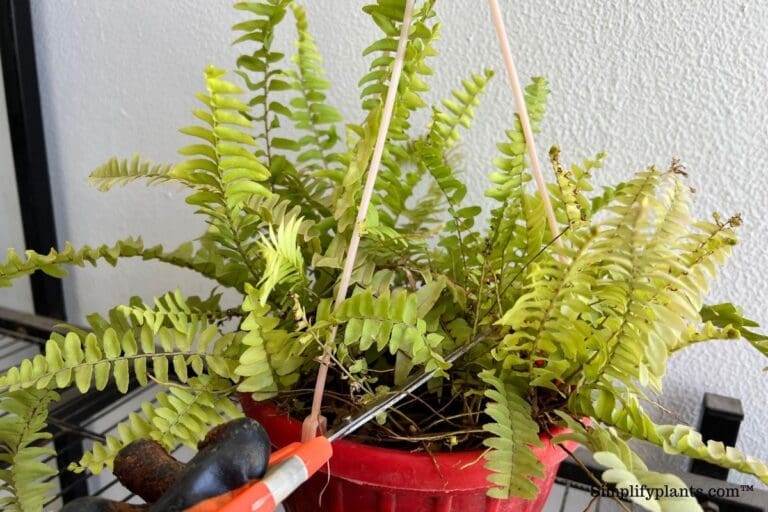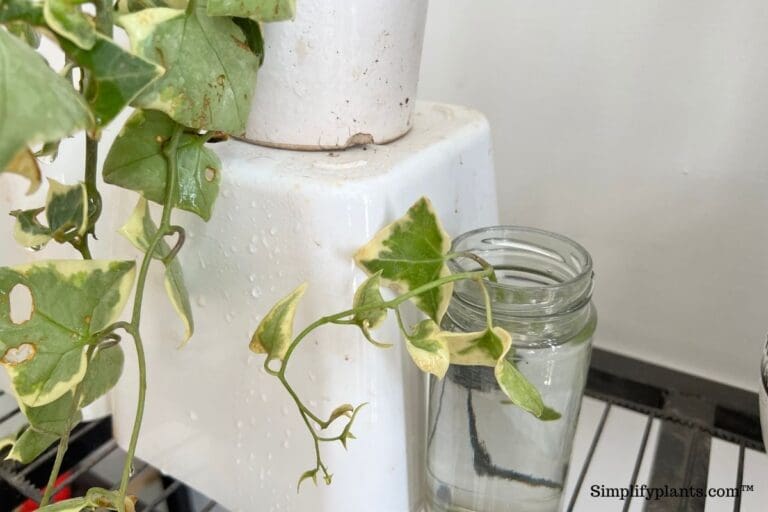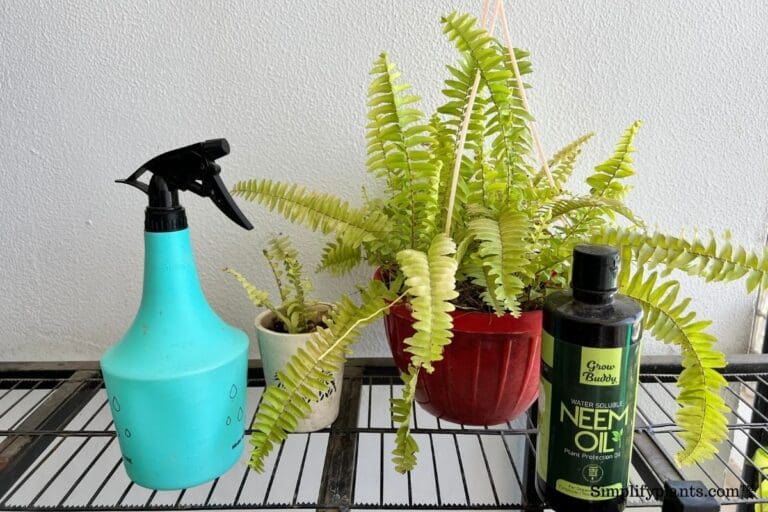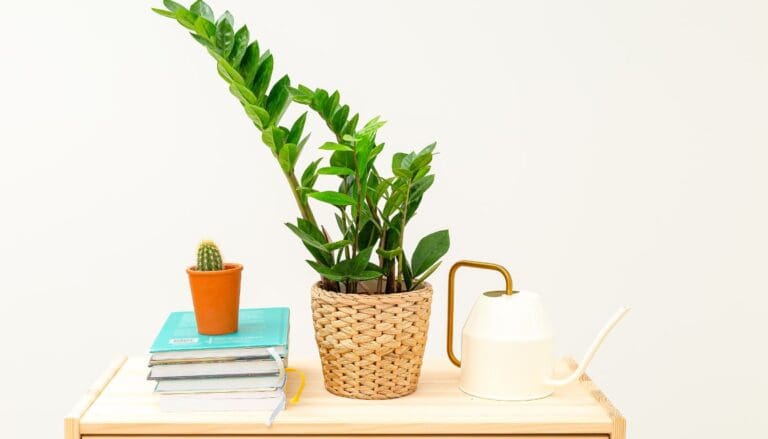Why Does My Fiddle Leaf Fig Have White Spots? (Causes+What To Do)
Fiddle leaf figs (Ficus lyrata) are loved for their beautiful large leaves but don’t ignore the white spots on your fiddle leaf fig. The chances are that those white spots are signs of some problem in your plant.
Using hard water for watering, pest infestation, and fungal infection are common causes of white spots on your fiddle leaf fig. However, you can get rid of white spots by using the appropriate type of water, misting the plant with neem oil, and keeping it away from direct sunlight.
Determining the cause of the problem is the first step to fix it. So, we will get into the details of why your fiddle leaf fig has white spots and how to get rid of them.

Please note: Simplify Plants is reader-supported. Some links in the post are affiliate links and I get a commission from purchases made through links in the post.
What causes white spots in fiddle leaf figs?
Some common causes of white spots on fiddle leaf figs include:
- Hard water spots
- Powdery mildew
- Pest infestation
- Sunburn
Apart from these, there can be some other problems as well, but you must always start by checking for them first as these are the most common ones.
Let’s understand these problems and the possible solutions that will help you to fix the white spots on your fiddle leaf fig.
How do I get rid of white spots on my fiddle leaf fig?
To get rid of the white spot on fiddle leaf fig, ensure the water you use doesn’t contain harmful minerals, and try to keep the pests away by using organic miticides from time to time. Also, don’t expose the plant to direct sunlight. Let’s dive into further details of the same.
Hard water spots on fiddle leaf fig

When the leaves of your fiddle leaf fig start showing a white chalky texture, it is due to the water that you are using.
When you use tap water on the fiddle leaf fig, it leaves behind the minerals such as chlorine, sodium, magnesium, calcium, etc.
These minerals start building upon the leaves and make them dull and white.
Soluble fertilizers can also deposit salt on the fiddle leaf fig leaves that become a reason for the white spots.
The buildup of harmful minerals and sodium on the leaves of your fiddle leaf fig doesn’t allow the plant to absorb water or nutrients, thus making it weak.
If you notice hard water spots on your fiddle leaf figs, stop using direct tap water on the plant.
You should check the water and change it. For example, you can use filtered water or collect rainwater and use it.
If these options are unavailable, leave the water outside for some time and let it get aerated, and then use it on your plant.
Here is how you can get rid of these spots without being harsh on the plant.
Supplies required:
- Half gallon distilled water
- 1 tsp natural soap (detergent-free)
- Microfiber cloth
- Spray bottle
To disintegrate the minerals, spray clean water on the leaves of your fiddle leaf fig and let it sit there for a few minutes.
Prepare a mixture by adding the soap to the distilled water. Soak the microfiber cloth in it and wipe the leaves of the plant gently with it. Go slow and try to be as gentle as possible.
Rinse the plant or shower it to wash away the soap. Ensure that the soapy water does not get into the soil.
Powdery mildew on fiddle leaf fig
Fungal disease such as powdery mildew causes the growth of fluffy, white, and powdery substance on your fiddle leaf fig leaves.
Lack of air circulation causes this fungal infection. Initially, these look like small white or grey spots that eventually grow larger and fluffier.
Powdery mildew can be very harmful to your fiddle leaf fig. So if you notice it, act immediately.
Powdery mildew makes the plant weak and creates an environment where pests can attack and thrive. In addition, it causes diseases that ultimately kill your plant.
If you have an affected plant, you should make sure that the fungus doesn’t spread.
Misting helps in the spread of the fungus when the water drips from one leaf to the other. So, avoid misting the plant.
Try not to rub it off, as that only encourages the spread of powdery mildew.
The following steps will help you to get rid of powdery mildew and treat your plant.
- Quarantine the plant and separate it from the other plants so that the infection doesn’t spread.
- Avoid keeping the plant in a damp area and allow air to flow around the plant. You can place it near a window that allows enough air to come indoors.
- You can remove the affected leaves by pruning them with a pair of sterilized scissors.
- If the infection has spread to a larger area of the plant, then mix 1 tsp of baking soda with 1 quart of water and spray on the leaves.
Pest infestation on fiddle leaf fig

Some common types of pest that infest the fiddle leaf figs are:
Spider mites
Spider mites are extremely tiny bugs that are mostly found on the underside of the tips of the leaves. You might notice spider mite webs and eggs that are as tiny as the pests.
It is hard to notice these pests. But if you see a whitish tint on the leaf, it may be due to spider mites.
Here is how you need to get rid of the spider mite infestation.
- Shower the plant and make sure that the leaves are getting washed on both sides.
- Prepare a spray by mixing neem oil and water. Spray it on all parts of the plant. Spray the leaves very well on both sides and leave them on the plant. Don’t wash off the solution.
- Repeat the second time after 4-5 days and the third time after 4-5 days from the second spray.
If you have an infected plant, you should isolate it so that the infection doesn’t spread to other plants. Or else, you can use the same treatment on the other plants to be on the safe side.
Mealybugs
If you notice a soft cotton-like substance on the leaves of your fiddle leaf fig, these are mealybugs infesting your plant. They also expel a powdery and sticky substance.
Mealybugs tend to infest tropical plants that make it hazardous for the fiddle leaf figs. These pests multiply very fast and are found on the underside of leaves, roots, or soil.
Mealybugs feed on the sap of the fiddle leaf fig and absorb all the nutrition from the plant, making it weak. As a result, the leaves lose their color, become white and yellow.
Mealybugs attract ants and other pests to the plant that leads to more infestations that can be deadly.
To get rid of the mealybugs, you need to remove the fiddle leaf fig from the other plants so that they can’t spread.
In the next step, you need to prune the affected leaves using a pair of sharp and sterilized scissors.
Using neem oil spray is one of the best ways to get rid of these pests.
However, you can also use natural and organic pesticides that won’t cause any harm to the plant.
And in case you are using a chemical pesticide, read the label carefully and check out the ingredients when buying.
Also read: How to get rid of pests in fiddle leaf fig?
Sunburn on fiddle leaf fig

Sunburn can be one of the reasons for the white spots on your fiddle leaf fig.
Fiddle leaf figs need a lot of indirect light but keeping them under direct sunlight scorches the leaves.
Sunburn can be very harmful as they affect the leaves permanently and, there is no cure other than pruning the leaves off.
If you have a sunburnt fiddle leaf fig, the leaves will start showing little brown spots that will gradually turn yellow or white or reddish-brown.
All you need to do is find the right place for your fiddle leaf fig where it gets sufficient light without being exposed to the direct harsh rays of the sun.
Choose a spot where your fiddle leaf fig gets 6-8 hours of consistent indirect light daily. A south-facing window will be ideal for this purpose.
If you have to place the fiddle leaf fig outdoors, keep it under a shade so that it stays protected from the harsh sunlight.
Also read: How to fix sunburn in fiddle leaf fig?
Preventing white spots on fiddle leaf figs
Ensuring that the fiddle leaf fig leaves don’t have white spots is simple; you need to take care of the plant.
The factors that you need to take care of are:
Light

Fiddle leaf figs appreciate a lot of light. These are tropical plants that get a lot of light in their native land.
When you have an indoor fiddle leaf fig, you need to provide sufficient light to it. The ideal lighting condition for the fiddle leaf fig would be bright indirect light for 6-8 hours every day.
Low light attracts pests and encourages fungal growth. In addition, the soil is unable to dry out, which creates the perfect environment for pests and fungus.
On the other hand, if you place your fiddle leaf fig under direct sunlight, it will scorch the leaves.
You should make sure that the fiddle leaf fig gets enough light which is not direct. If your house doesn’t get enough sunlight, you can use grow lights which are artificial lights that are used as a replacement for natural light.
Also read: How much light do fiddle leaf fig need?
Water

Overwatering is the most common problem that can cause various issues and diseases in plants.
Fiddle leaf figs don’t like to sit on the water so, if it remains in the water for too long, the plant will have root rot that will encourage the growth and spread of fungus in the soil. It will also attract pests that will make the plant even more vulnerable.
Fungal growth and pest infestation are reasons for overwatering, and that develops white molds and white spots on your fiddle leaf fig.
Water the fiddle leaf fig as per the requirements of the plant. Always check the soil’s moisture by using a moisture meter or sticking your finger inside the soil.
Avoid watering if the soil feels moist. Instead, make sure that the excess water is getting drained away through the pot’s drainage holes.
Don’t use hard water on the plant as that will also have white residue on the leaves. Instead, use distilled water or rainwater.
During the winter season, the plant becomes dormant, so you should water less during the winter.
Also read: How often should I water my fiddle leaf fig?
Fertilizing

Fertilizers are essential for fiddle leaf figs as they need a lot of nutrition that the soil alone cannot provide.
Overfertilizing, however, can be harmful to the plant, its roots, and the soil. In addition, Overfertilizing reduces the quality of the soil and makes pest infestation and fungal or bacterial growth easier.
Use light and diluted fertilizer that has all the nutrients that the fiddle leaf fig needs. Try to use organic fertilizers instead of chemical ones.
Avoid fertilizing the plant during winter as the plant rests and doesn’t grow during that time of the year.
Also read: Do fiddle leaf fig need fertilizer?
Pruning

Pruning encourages healthy growth and helps the plant to stay in good shape. However, not pruning the plant often leads to a lot of problems.
Brown leaves or yellow leaves, curling leaves, leggy growth – all are caused due to lack of pruning. All these problems attract pests.
Therefore, you need to prune the fiddle leaf fig often to make sure that it remains in good health.
Use a pair of sharp and sterilized scissors to prune the damaged leaves, leggy branches. Make clean cuts and water the plant thoroughly after pruning it so that it does not get stressed.
Repotting

Fiddle leaf figs tend to get rootbound if you don’t repot the plant. A rootbound plant can’t grow the roots further and cannot absorb water and nutrients with its roots.
Repotting is necessary not only when the plant gets root-bound but also for the overall wellbeing of the plant.
Repot your fiddle leaf fig in fresh soil mix in once every 2-3 years which allows the plant to get more nutrition as the old soil loses nutrients over time.
Consider getting a larger-sized pot than the old one so that the roots can grow freely. And make sure that there are drainage holes to let the excess water get washed away.
Also read: Do fiddle leaf fig like to be root bound?
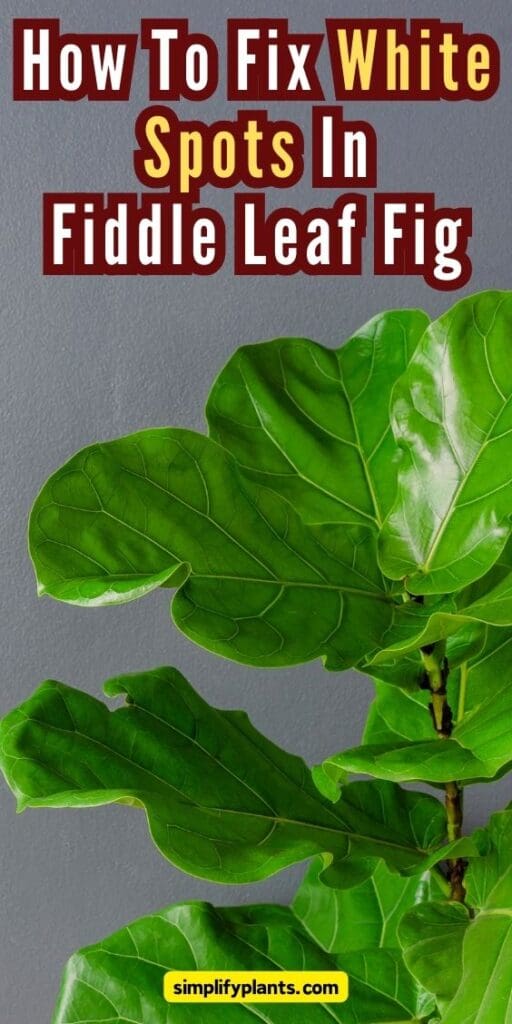
Tips for a healthy fiddle leaf
- Provide 6-8 hours of consistent indirect light to the plant.
- Don’t water if the soil feels moist.
- Repot the plant every 2-3 years.
- Prune the plant frequently to get rid of damages and leggy growth.
- Use pesticides and fungicides to keep the pests and fungus away from your fiddle leaf fig.
Sources: CABI.ORG, New York Botanical garden, University of Florida.
Recommended Garden Supplies
| Product Image | Our Recommended Gardening Supplies | Check Offers! |
|---|---|---|
Top Top
Top
Top
Top
Top
Top
Top
Top | rePotme Houseplant and Tropical Classic Potting Soil Mix | Check Offer On Amazon |
 Top
Top
Top
Top
Top
Top
Top
Top | Espoma Organic Indoor Plant Food | Check Offer On Amazon |
 Top
Top
Top
Top
Top
Top
Top
Top | GooingTop LED Grow Light 6000K Full Spectrum Clip Plant Growing Lamp | Check Offer On Amazon |
 Top
Top
Top
Top
Top
Top
Top
Top | Soil Moisture Meter | Check Offer On Amazon |
 Top
Top
Top
Top
Top
Top
Top
Top | Govee Hygrometer Thermometer, Bluetooth Enabled! | Check Offer On Amazon |
 Top
Top | LEVOIT Humidifiers for Large Room(Best For Plants) | Check Offer On Amazon |
 Top
Top
Top
Top
Top
Top
Top
Top | Upgraded DIY Automatic Drip Irrigation Kit, 15 Potted Houseplants Support | Check Offer On Amazon |
 Top
Top
Top
Top
Top
Top
Top
Top | Stainless Steel Heavy Duty Gardening Tool Set | Check Offer On Amazon |
 Top
Top
Top
Top
Top
Top
Top
Top | Bonide Insecticidal Soap | Check Offer On Amazon |
 Top
Top
Top
Top
Top
Top
Top
Top | Bonide 32 oz Spray Neem Oil for Organic Gardening | Check Offer On Amazon |
 Top
Top
Top
Top
Top
Top
Top
Top | Garden Safe Fungicide | Check Offer On Amazon |

